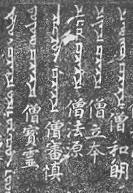Inside Malcuno Zcuro
 Wolfgang has kindly sent a view of the inside of Malcuno Zcuro, both in the Syriac script and in the Latin script. The book also has a wordlist at the bottom of each page which makes it even more attractive for language learners. Click on these images to enlarge.
Wolfgang has kindly sent a view of the inside of Malcuno Zcuro, both in the Syriac script and in the Latin script. The book also has a wordlist at the bottom of each page which makes it even more attractive for language learners. Click on these images to enlarge.I am reposting Wolfgang's email since he provides this interesting information.
Saint-Exupery's "Le Petit Prince" was translated by the "Circle of Aramaic Students" at Heidelberg University, Germany.
I contacted the professor who initiated the Aramaic translation. He assured me that "zcuro" is the correct
 translation for "little" as far as the Tur Abdin dialect is concerned. He assumes that the persons who came up with "zeuro" must have consulted a dictionary of the Old Aramaic language.
translation for "little" as far as the Tur Abdin dialect is concerned. He assumes that the persons who came up with "zeuro" must have consulted a dictionary of the Old Aramaic language.BTW a copy of "Malkuno Zcuro" (ISBN 3-937467-15-7) can be obtained from the following book company:
http://www.verlag-tintenfass.de/
info@verlag-tintenfass.de
And yes I did consult a dictionary of Old Aramaic. However, I have since looked at a few books that are available at Amazon.com on Syriac. These include a dictionary, grammar and various other books. In one I found an example of Syriac vocabulary transcribed with the left half ring for the 'ayn as had been suggested ea
 rlier by Simon. However, in the Little Prince orthography the 'ayn is written with a 'c'.
rlier by Simon. However, in the Little Prince orthography the 'ayn is written with a 'c'.Books available at Amazon.com on Syriac are A Compendious Syriac Dictionary and an Introduction to Syriac: An Elementary Grammar With Readings from Syriac Literature with this editorial review.
Syriac is the Aramaic dialect of Edessa in Mesopotamia. Today it is the classical tongue of the Nestorians and Chaldeans of Iran and Iraq and the liturgical language of the Jacobites of Eastern Anatolia and the Maronites of Greater Syria.
Syriac is also the language of the Church of St. Thomas on the Malabar Coast of India. Syriac belongs to the Levantine group of the central branch of the West Semitic languages. Syriac literature flourished from the third century on and boasts of writers like Ephraem Syrus, Aphraates, Jacob of Sarug, John of Ephesus, Jacob of Edessa, and Barhebraeus.
After the Arab conquests, Syriac became the language of a tolerated but disenfranchised and diminishing community and began a long, slow decline both as a spoken tongue and as a literary medium in favor of Arabic. Syriac played an important role as the intermediary through which Greek learning passed to the Islamic world. Syriac translations also preserve much Middle Iranian wisdom literature that has been lost in the original.
Tim May has pointed out that Meltho Open Type Syriac fonts are available Beth Mardutho.
 Syriac is notable for being one of the scripts on the Xian Stele in China, as well as on the tombstones in Quangzhou. (I have not found and image for this yet.)
Syriac is notable for being one of the scripts on the Xian Stele in China, as well as on the tombstones in Quangzhou. (I have not found and image for this yet.)
(Oddly the Estrangelo Syriac script also appears on the bookplate for the Gleason Moss Collection of H.A. Gleason, Jr., who was my first and well-loved linguistics professor. His father was the botanist H.A. Gleason.)
And finally a nice link here to look at a few related scripts and their transcriptions together in a table. And there is the right half ring and the left half ring. Now I get it.
Actually I intended to end here but really I have to identify the variant of Syriac script which appears in Malkunoc Zcuro. It looks like Jacobite or Serto script from comparison with the Omniglot page. At Amazon dot com I have found a Syriac Bible in the Jacobite script.
Here is a clip from the Syriac Bible: Jacobite Script, Ancient and for comparison a chunk of non-continuous text from Malkuno Zcuro.

Would it be fair to say that Syriac has several diascripts? Hmm.


2 Comments:
You can also look at the exciting Syriac support in Windows XP and Server 2003. :-)
Hi Mike,
I was just thinking about it when I saw your comment. I have now installed the keyboard - I am using the 'phonetic' keyboard since it is so close to English. I am playing with it in BabelPad so I can look at the connected and isolated forms of the letters by clicking on the u. Lots of fun.
Post a Comment
<< Home